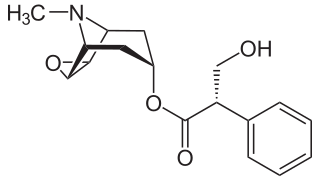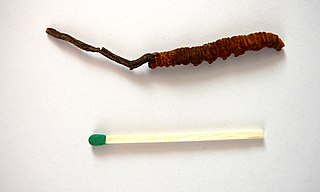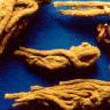
Scopolamine, also known as hyoscine, or Devil's Breath, is a natural or synthetically produced tropane alkaloid and anticholinergic drug that is formally used as a medication for treating motion sickness and postoperative nausea and vomiting. It is also sometimes used before surgery to decrease saliva. When used by injection, effects begin after about 20 minutes and last for up to 8 hours. It may also be used orally and as a transdermal patch.

"Truth serum" is a colloquial name for any of a range of psychoactive drugs used in an effort to obtain information from subjects who are unable or unwilling to provide it otherwise. These include ethanol, scopolamine, 3-quinuclidinyl benzilate, midazolam, flunitrazepam, sodium thiopental, and amobarbital, among others.

Hyoscyamine is a naturally occurring tropane alkaloid and plant toxin. It is a secondary metabolite found in certain plants of the family Solanaceae, including henbane, mandrake, angel's trumpets, jimsonweed, tomato, the sorcerers' tree, and deadly nightshade. It is the levorotary isomer of atropine and thus sometimes known as levo-atropine.

Twilight sleep is an amnesic state characterized by insensitivity to pain without loss of consciousness, induced by an injection of morphine and scopolamine, with the purpose of pain management during childbirth. The obstetric method originated in Germany and gained large popularity in New York City in the early 20th century.

Hibiscus rosa-sinensis, known colloquially as Chinese hibiscus, China rose, Hawaiian hibiscus, rose mallow and shoeblack plant, is a species of tropical hibiscus, a flowering plant in the Hibisceae tribe of the family Malvaceae. It is widely cultivated as an ornamental plant in the tropics and subtropics, but its native range is Vanuatu.

Ophiocordyceps sinensis is known in English colloquially as caterpillar fungus, or by its more prominent names dōng chóng xià cǎo, literally "winter worm, summer grass"), or yartsa gunbu (Tibetan: དབྱར་རྩྭ་དགུན་འབུ་, Wylie: dbyar rtswa dgun 'bu, or Yarsa-gumba or Yarcha-gumba, or Keeda Jadi, or ရှီးပတီး. It is an entomopathogenic fungus in the family Ophiocordycipitaceae. It is mainly found in the meadows above 3,500 meters on Tibetan Plateau in Southwest China and Himalayan regions of Bhutan and Nepal. It parasitizes larvae of ghost moths and produces a fruiting body which used to be valued as a herbal remedy and in traditional Chinese medicine. Caterpillar fungus contains the compound cordycepin, an adenosine derivative. However, the fruiting bodies harvested in nature usually contain high amounts of arsenic and other heavy metals so they are potentially toxic and sales have been strictly regulated by the CFDA since 2016.

Camellia sinensis is a species of evergreen shrubs or small trees in the flowering plant family Theaceae. Its leaves and leaf buds are used to produce tea. Common names include "tea plant", "tea shrub", and "tea tree".

Angelica sinensis, commonly known as dong quai or female ginseng, is a herb belonging to the family Apiaceae, indigenous to China. Angelica sinensis grows in cool high altitude mountains in East Asia. The yellowish brown root of the plant is harvested in the fall and is a well-known Chinese medicine which has been used for thousands of years.

Deliriants are a class of hallucinogen. The term was coined in the early 1980s to distinguish these drugs from psychedelics and dissociatives such as LSD and ketamine, due to their primary effect of causing delirium, as opposed to the more lucid and less disturbed states produced by other types of hallucinogens. The term generally refers to anticholinergic drugs, which are substances that inhibit the function of the neurotransmitter acetylcholine. Common examples of deliriants include plants of the genera Datura and Brugmansia as well as higher than recommended dosages of diphenhydramine (Benadryl). A number of plant deliriants such as that of the Solanaceae family, particularly in the Americas have been used by some indigenous cultures to reach delirious and altered states for traditions or rituals, such as rites of passage, divination or communicating with the ancestors. Despite their long history of use, deliriants are the least-studied class of hallucinogens in terms of their behavioral and neurological effects.

Hyoscine butylbromide, also known as scopolamine butylbromide and sold under the brandname Buscopan among others, is an anticholinergic medication used to treat crampy abdominal pain, esophageal spasms, renal colic, and bladder spasms. It is also used to improve respiratory secretions at the end of life. Hyoscine butylbromide can be taken by mouth, injection into a muscle, or into a vein.

Scopolia is a genus of four species of flowering plants in the family Solanaceae, native to Europe and Asia. The genus is named after Giovanni Scopoli (1723–88), a Tyrolean naturalist. The genus has a disjunct distribution, with two recognised species in Central to Eastern Europe,, and two species in East Asia. The two European species are:

The Chinese softshell turtle is a species of softshell turtle that is native to China and Taiwan, with records of escapees—some of which have established introduced populations—in a wide range of other Asian countries, as well as Spain, Brazil and Hawaii.

The Asian parti-colored bat is a species of parti-coloured bat. An adult Asian parti-colored bat has a body length of 6–7 cm, a tail of 4.3-4.5 cm, and a wing length of 5 cm. Asian parti-colored bats are distributed across East Asia, from Taiwan through eastern China, eastern Mongolia and Russia (Siberia) to the Korean Peninsula and Japan.

A muscarinic receptor antagonist (MRA) is a type of anticholinergic agent that blocks the activity of the muscarinic acetylcholine receptor. The muscarinic receptor is a protein involved in the transmission of signals through certain parts of the nervous system, and muscarinic receptor antagonists work to prevent this transmission from occurring. Notably, muscarinic antagonists reduce the activation of the parasympathetic nervous system. The normal function of the parasympathetic system is often summarised as "rest-and-digest", and includes slowing of the heart, an increased rate of digestion, narrowing of the airways, promotion of urination, and sexual arousal. Muscarinic antagonists counter this parasympathetic "rest-and-digest" response, and also work elsewhere in both the central and peripheral nervous systems.

Anisodamine, also known as 7β-hydroxyhyoscyamine, is an anticholinergic and α1 adrenergic receptor antagonist used in the treatment of acute circulatory shock in China. It is given orally or by injection, as a racemic mixture (racanisodamine) or as a hydrobromide salt. Eye drops at 0.5% concentration for slowing the progression of myopia is also available in China.
The molecular formula C16H19NO4 may refer to:

Blarcamesine is an experimental drug developed by Anavex Life Sciences.

Camellia taliensis is a species of evergreen shrub or small tree whose leaves and leaf buds are used to produce tea.
Atropanthe is a genus of flowering plants belonging to the family Solanaceae.
















